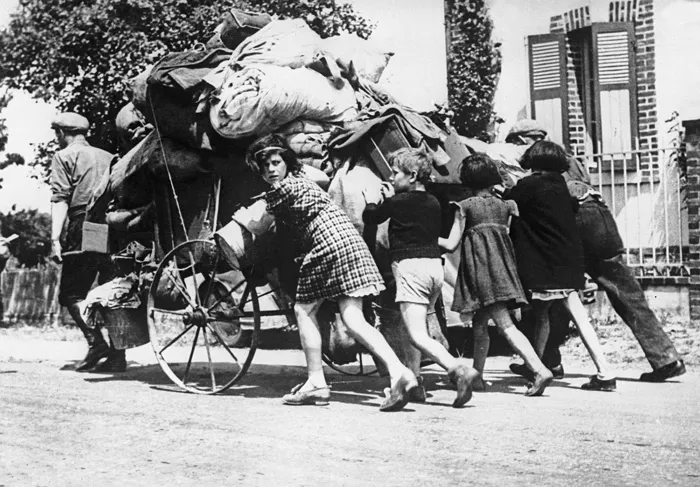Over a few days in June 1940, some two million people left Paris ahead of the Nazi invasion. Some had the money or connections to relocate in good time but many, like the family in the photograph above, piled their possessions haphazardly onto whatever vehicle was available and headed south, trusting to luck. No trains were running.
The situation soon became desperate.
Their ranks were swelled by those who had already fled Hitler’s forces in Belgium, Holland and northern France. The roads were crowded with people on foot or pulling carts and blocked by abandoned cars that had run out of petrol. In the chaos, children became separated from their parents. Food ran out after a few days. The villages and towns along the way were unable to accept such a huge influx of people and were not always hospitable. As well as all this, German attacks from the air were a constant danger. Astonishingly, 100,000 of the refugees did not survive.
It was into this historic event that I placed my own characters in Swimming with Tigers.
Researching a historical novel is not the same as being a historian. I did of course need to know the basic facts and geography of what became known as L’Exode (the Exodus), but I knew that it was the anecdotes and small details that would give me what I needed to make the experience real for my readers.

Fortunately, I hit upon the account of Elizabeth née Munk Oppenheim, a German living in France who left Paris with friends on foot as part of the exodus of 1940. Her husband, an Austrian, had been interned in France at the start of the war, leaving her with not enough to live on. There was no alternative but to join the exodus, and she describes how her friend had to abandon a pram on the road and carry her 6-month-old son instead.
In the towns they passed through, there were soup kitchens and theatres with floors covered in straw for them to sleep on. Railway stations were thronged, and she remembers the stench because people were using the tracks as toilets. Wearing a man’s raincoat, heavy rucksack and with her hair cut short against vermin, she was taken for a man at one point. I put all of this into my novel.
Another incident I borrowed was when Elizabeth was bitten by a cat while standing in line. When the bite became infected, she was treated by a dentist who was the only medically qualified person available. My character has the same misfortune but is cared for by a vet instead. I also included the story of how Elizabeth cooked and ate some dates that were crawling with worms (maggots, presumably) because there was nothing else to eat. You can read Oppenheim’s extraordinary testimony here.
Elizabeth Oppenheim was able to leave France by train because she had at least some of the official papers needed. In contrast, my characters had a very different challenge. As did some 88,000 refugees by the end of the war, they escape on foot over the Pyrenees, the mountain range that separates France from Spain.

This escape route was used in order to evade the various checkpoints on the border. Famously, Varian Fry, the ‘American Schindler’ and his Emergency Rescue Committee assisted people attempting this arduous route. Because my scenes are set in 1940, which was early in the war, I chose the eastern route across the Pyrenees from Cebère in France to Portbou in Spain for my characters. Later, this route was heavily guarded and could no longer be used.
I also included a meeting between one of my characters and a fictionalised group of real-life famous refugees who made this journey. The group included Alma Mahler-Werfel and her husband Franz Werfel, author of The Song of Bernadette. Alma, formerly married to the composer Mahler, was carrying some of his precious manuscripts as well as the score of Bruckner’s Third Symphony.
Also with her were members of the novelist Thomas Mann’s family including his son, his brother and his brother’s wife Nelly. Varian Fry went with their extensive luggage by train to Spain while the group were led by a guide over the mountains. Alma was wearing sandals and Nelly had on a fur coat.

Taking my usual liberties with the facts, I wrote scenes in which a version of this eccentric, polyglot group team up with my character and, with the help of bribes, make it across the border. I borrowed the detail of bribing the border guards with cigarettes from a now-disappeared online account of Clare Ehrmann’s experiences of crossing the Pyrenees.
My character then has to make her way somehow, as thousands did, to Lisbon in Portugal where, by securing passage on a ship or aircraft, Jewish and other targets of Nazi hatred could leave Europe for safety in the US and elsewhere. Those who made it as far as Lisbon were astonished at the normality of life in bars and restaurants there. Seeing the shops full of sweets in Lisbon, Elizabeth Oppenheim said her tongue was hanging out. My character’s experience is the same; it must have been like a dream come true after so much hardship and privation.
At a time when huge numbers of people worldwide are displaced from their homes or who arrive on our shores having fled for their lives, I believe that personal stories and human details in historical fiction can be one of the best ways to understand and empathise with their plight.
When I imagine having to pack up some limited belongings and leave the home that I love, it terrifies me and writing the scenes in which my characters are homeless, unprotected and at risk was upsetting and difficult. How much harder for those millions, then and now, with no option but to flee persecution and war?
Here is a link to an article with more details about L’Exode.

